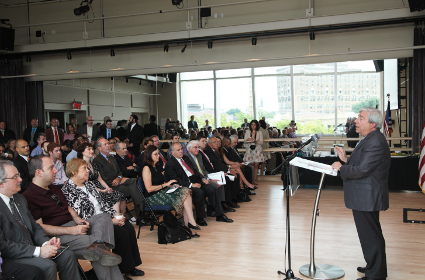
There’s just no stopping fast pace of Downtown Brooklyn growth

The renaissance of Downtown Brooklyn seems like a unstoppable explosion, state Comptroller Thomas DiNapoli suggested on Thursday.
Consider these statistics, which he presented to an enthusiastic audience at the BAM Fisher Building:
• Total private-sector jobs in greater Downtown grew by 18.3 percent from 2003 to 2010, he said — far higher than the growth rate in the rest of Brooklyn (11.4 percent) and more than three times the rest of the city (5.4 percent).
• Similarly, wages grew by 48 percent in Downtown between 2003 and 2010 —a spectacular rate compared with than for the rest of Brooklyn (29.4 percent) and the rest of the city (38.2 percent).
“My Aunt Mary worked on Joralemon Street and retired in the 1960s,” DiNapoli said. “I wonder what she would think of the area now?”
At Thursday’s event, DiNapoli presented a report, “An Economic Snapshot of the Greater Downtown Brooklyn Area,” and the Downtown Brooklyn Partnership unveiled its “Downtown Brooklyn Strategic Plan.”
Among Downtown’s often-repeated bullet-points are these:
• The area has 57,000 college students, more than Cambridge, Mass.
• Its “Tech Triangle,” stretching from the Brooklyn Navy Yard to Downtown Brooklyn to DUMBO, is home to more than 500 high-tech firms.
• There are about 50 cultural institutions and organizations in Downtown, many of them part of the BAM Cultural District.
• High-profile new retailers — H&M, Century 21, Aeropostale, Shake Shack, Brooklyn Industries — either have come or will be coming to the Fulton Mall.
• And, of course, we’ve got the Nets.
How long can this phenomenal success continue?
Partnership co-chairman Alan Fishman said the objective of the strategic plan is to insure that the Downtown Brooklyn’s “flash-in-the pan” is transformed into a “blue chip.”
 Partnership President Tucker Reed presented these recommendations to ensure continued growth:
Partnership President Tucker Reed presented these recommendations to ensure continued growth:
• One is to “highlight the pedestrian experience.”
“Although the distance between BAM and the Brooklyn Bridge is about the same as the distance over the bridge, it feels much longer,” he said. The report calls for creation of a system of parks, plazas, greenways and green spaces.”
• Another is to diversify the business district.
In the past, he said, the area mainly attracted the back offices of large Manhattan corporations. The Partnership can try to attract more high-tech and other firms, and build links between key sectors as the legal community, educational institutions and healthcare.
• “Make Downtown Brooklyn a College Town.”
The partnership recommends making students at all of the area’s higher educational instructions — including NYU Poly, LIU Brooklyn, St. Francis, CityTech and Brooklyn Law — aware of the area’s cultural and entertainment options, and holding events that would attract students from different institutions.
• Connect the area’s arts and cultural groups with businesses and residential communities to promote the area as a world-class cultural district.
Reed paid tribute to the borough’s past business leaders, saying, “We are standing on the shoulders of giants.” He singled out Robert Catell, who led Brooklyn Union Gas before the company evolved into National Grid; and Fishman who led Independence Savings Bank and who has been active in many Brooklyn institutions, including BAM itself.
DiNapoli’s report presented a number of other findings:
• The main fields of employment in Downtown are health care, educational services, business services and finance. The average private-sector salary in the area ($47,890 in 2010) was more than 30 percent higher than in the rest of Brooklyn ($36,500).
• About two-thirds of area residents live in rental housing — but a growing share, which rose from 1.4 percent in 1999 to 16.6 percent in 2008, live in condos. In the rest of Brooklyn, that figure rose only from 1.9 percent to 4.8 percent.
• The office vacancy rate in Downtown improved from 11.1 percent in the first quarter of 2011 to 7.4 percent in the first quarter of 2012. The average office rent in the area, $29.92 per square foot, is significantly lower than in Manhattan, making it attractive to new firms.
In discussing “Arts and Cultural Organizations in the Greater Downtown Brooklyn Area,” DiNapoli reviewed the founding of the BAM Cultural District in 2004, renovation of the 80 Arts Building, and development of the Theatre for a New Audience, currently under construction on the site of a former parking lot. This section of the report also gives a brief description of established institutions such as the Brooklyn Historical Society, the Transit Museum, and BAM itself.
Leave a Comment
Leave a Comment


